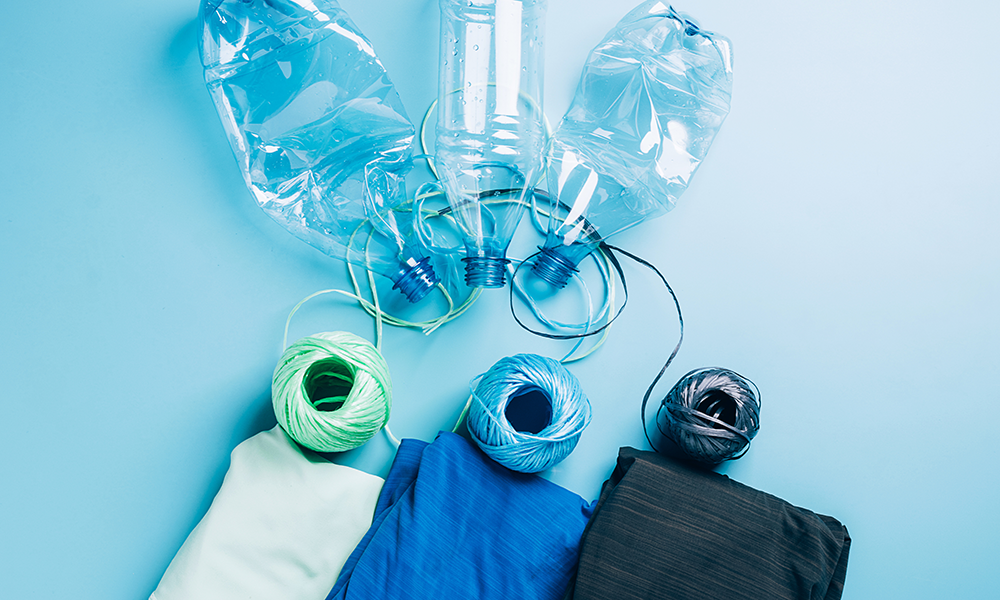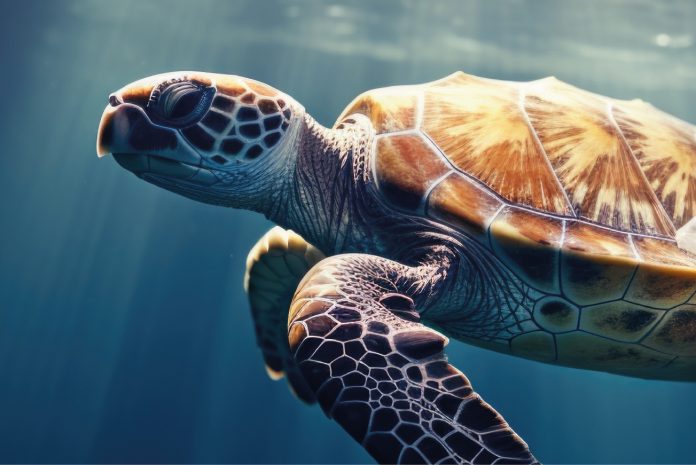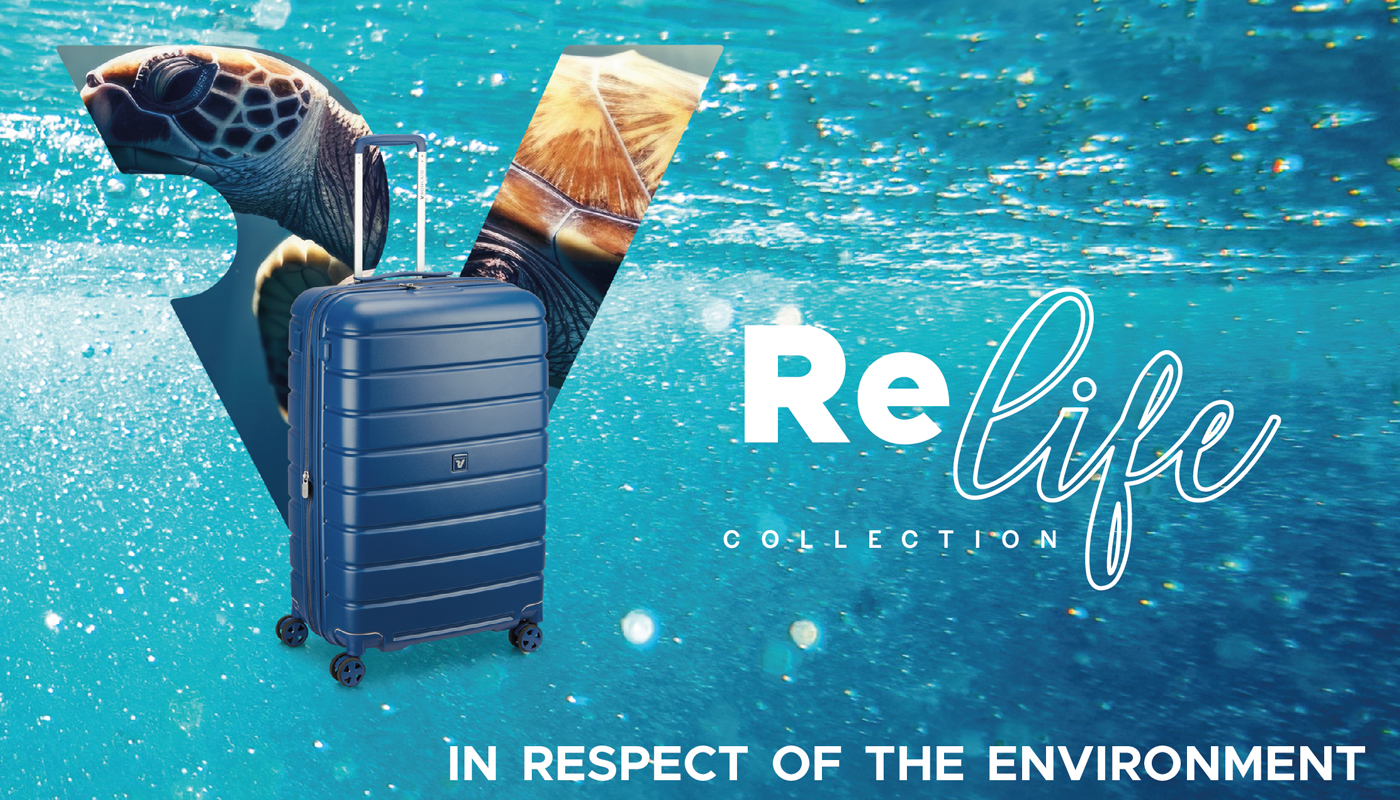Valigeria Roncato, with its new eco-sustainable collections, is committed to using as many raw materials derived from recycled post-consumer materials as possible. For example, in the case of the Relife collection, the shells and the inner lining are made with RPET, a material made from recycled bottles, demonstrating Valigeria Roncato’s commitment to protecting our planet.
By purchasing those trolley, in fact, you will contribute to the protection of the environment. Less plastic waste will be released into circulation because plastic is used to produce essential parts of this product.

From the calculations we have carried out, in fact, to make the components of a small trolley it takes around 55 plastic bottles, to make the components of a medium trolley it takes around 91 and to make the components of a large trolley about 116 are needed.
The recycling process starts from the collection of plastic bottles, necessary to eliminate waste from our environment. Then we move on to the actual recycling process and the production of the recycled material (RPET) with which the main components of the trolley are made.
It should be noted that the innovative system of removable wheels allows for a reduction in air pollution also from the point of view of CO2 released into the environment, since the transport of these products from the production sites to the shops and/or to the home of the final consumer takes place without wheels, thus reducing the transport volume by approximately 10% compared to products of the same category.
Protecting the environment with recycled materials:
For now it’s just a dream, in fact living totally without plastic is not possible yet. However, we are lucky that there are now many eco-sustainable alternatives on the market that allow us to use the advantages of plastic as a material without burdening the environment too much. An alternative is RPET.
What is RPET?

We all know PET bottles. PET stands for polyethylene terephthalate and is produced from crude oil and natural gas. It’s colourless and highly translucent, and it be moulded into many different shapes. Since it is also very impact-resistant, it’s ideal for the production of travel items.
When PET is recycled, RPET, which is recycled polyethylene terephthalate, is produced. This plastic is made from 100% recycled PET bottles and is therefore much more resource efficient than “normal” PET.
To produce RPET, PET bottles are cleaned and shredded and then transformed into new packaging material by melting. This process saves energy and resources because no crude oil is used. For example, a RPET bottle consumes up to 75% less energy in production compared to a normal plastic bottle. At the same time, this also reduces CO2 emissions.
Another ecological aspect of these trolleys made of RPET is that fewer plastic bottles end up in the garbage and therefore in landfills. And last but not least: these TROLLEY PRODUCTS in RPET are also recyclable.
Valigeria Roncato is proud to be part of this cycle!
In detail: the steps that plastic undergoes at the recycling and transformation plant before becoming R-PET are the following:
- The importance of separate waste collection: in order to correctly classify and separate used plastic by shape and colour, it’s essential that it is already separated from the rest of the waste at the source (in our homes, companies, etc.). Any labels and caps are then removed from the used plastic and an initial external washing is carried out.
- The second step consists in shredding the used bottles and waste into flakes, which are then washed and dried several times.
- Subsequently the flakes, after having been heated for a long time, are melted into a liquid mass which, once cooled, is cut into threads;
- These threads are ultimately transformed into bottles, packaging, or other products.
Using RPET brings many environmental advantages, especially given by the reduction of CO2 emissions during the processing of materials, the saving of non-renewable resources and the transformation of plastic waste into a resource. A legislative innovation also concerns the fact that since January 2021 in Italy it’s possible to make 100% recycled PET bottles, which allows you to further contribute to environmental protection.
Tramite l’RPET, oltre alle bottiglie si possono realizzare anche tutta una serie di altri materiali, come i tessuti, che si ottengono da RPET con aggiunta, ad esempio, di cotone. Una grande rivoluzione, questa, anche nel settore della moda che, così facendo, da origine ad un circolo virtuoso di cui l’ambiente ha estremo bisogno.
Using RPET, in addition to bottles, a whole series of other materials can also be made, such as fabrics, which are obtained from RPET with the addition, for example, of cotton. This represents a great revolution also in the fashion sector which, in doing so, gives rise to a virtuous circle that the environment desperately needs.
The raw materials from which PET is derived, which are oil and natural gas, are non-renewable natural resources, therefore destined to run out with our consumption, it’s always an advantage to save them when possible.
Reusing a raw material is also a considerable benefit in terms of waste, because we don’t put new products on the market, but we recycle existing ones, not creating new rubbish that needs space and to be disposed of, and “saving” plastic from landfills.
This topic becomes even more virtuous if we consider that PET can be recycled and reused several times, because it does not lose its properties during the transformation process.
Following the three R rule, recycling is the third virtuous solution, to be followed when it is not possible to respect either of the first two. In fact the right order is: reduce, reuse and recycle. To reduce the use of plastic, the first rule is to choose compounds made of other materials; if this is not possible, the second rule is to reuse the same product times more times (and in the case of a suitcase this rule is certainly respected). Finally we come to recycling.
When we talk about recycling it’s inevitable to talk about the circular economy.
What does circular economy mean? Circular economy is a production and consumption model that implies operational concepts and actions such as sharing, repairing, reconditioning, lending, reusing and recycling existing materials and products, for the longest period possible. All this in order to extend the life cycle of the products. By doing this, the first consequence is the reduction of waste: when the product has finished its function, the materials it is made of are reintroduced through recycling, where possible. The end result is their reuse and the generation of further value.
Our company has always been careful towards environmental issues.
A few years ago we organized the cleaning of waste from some beaches on the Adriatic coast. We try to use eco-sustainable materials for our production, we develop products with a life cycle, and therefore excellent quality, as long as possible, in order to introduce less possible waste into the environment.
With the Relife project we wanted to do more, we wanted to create a suitcase made with recycled material to give a strong signal to the market and actively contribute to safeguarding the world around us, and in particular the sea.
The waste that invades our seas represents an important problem, not only for the negative externalities linked to the environmental and social costs deriving from the harmful effects on the ecosystem, but also for the direct costs that they can generate; examples are the costs for cleaning the coast or for mechanical damage to boats and fishing equipment.
The objective 14 of the 2030 Agenda for Sustainable Development focuses on the conservation of the oceans, seas and marine resources, through the prevention and reduction of all forms of marine pollution, especially that deriving from activities carried out on land, including marine debris and nutrient pollution.
Unfortunately the data is very alarming:
- every year 450 million tons of plastic are produced;
- about 8 million tons of plastic waste ends up in the oceans annually;
- more than 700 species have been affected by plastic pollution phenomena;
With regard to the various degradation times of plastics, it depends a lot on their type; at the first place there are fishing lines which take up to 600 years. This is followed by diapers, sanitary pads and plastic bottles which take up to 450 years. For a non-biodegradable plastic bag, however, it takes around 20 years.
A little curiosity: the degradation of plastics in the sea also depends on the position of the waste in the water column. If, as it occurs with floating objects, the plastics are on the surface they are subject to light, atmospheric agents (rain, wind, etc.) and rubbing with other materials; all this can in many cases accelerate the processes of fragmentation and subsequent degradation.
Plastic materials in the sea degrade in sunlight into small particles called microplastics, which gradually become smaller and smaller, also enter drinking water and remain suspended in the air, also damaging other organisms.
All this leads us to think about the importance of eliminating plastics that end up in the sea and all the actions we can all do to prevent it.
It’s vital that we continue our efforts to reduce plastic pollution and protect our seas and oceans.

 Italiano
Italiano Español
Español








